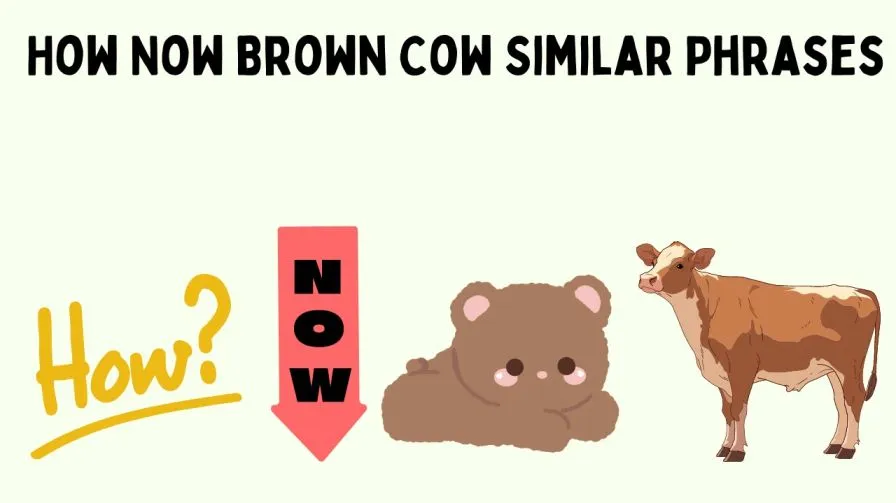Something that has amused generations is the sentence “How Now Brown Cow Similar Phrases” This straightforward sentence, based on an alliterative word combination, has been memorable in the history of both the English language and phonetics. But how does it relate to popular culture, and why has it persisted?

- “The rain in Spain stays mainly in the plain.” – Used for practicing the “ay” sound.
- “She sells seashells by the seashore.” – A classic tongue twister with alliteration.
- “Peter Piper picked a peck of pickled peppers.” – Another tongue twister emphasizing the “p” sound.
- “Red lorry, yellow lorry.” – A phrase challenging for its repetition and rhythm.
- “Unique New York.” – Tricky due to the rapid transition between similar sounds.
- “Fuzzy Wuzzy was a bear. Fuzzy Wuzzy had no hair. Fuzzy Wuzzy wasn’t very fuzzy, was he?” – A playful rhyme focusing on the “z” sound.
- “Betty Botter bought some butter, but she said the butter’s bitter.” – A tongue twister that emphasizes the “b” sound.
- “How much wood would a woodchuck chuck if a woodchuck could chuck wood?” – A phrase that plays with repetition and rhyme.
- “A proper copper coffee pot.” – An alliterative phrase focusing on the “p” and “c” sounds.
- “Six slippery snails slid slowly seaward.” – A tongue twister with repeated “s” sounds.
- “Round the rugged rock the ragged rascal ran.” – Alliteration with “r” sounds.
- “Crisp crusts crackle and crunch.” – Emphasizing the “c” and “k” sounds.
- “A big black bear sat on a big black rug.” – Repetition of “b” sounds.
- “Friendly fleas and fiery flies.” – Alliteration with “f” sounds.
- “I scream, you scream, we all scream for ice cream.” – Rhyme and repetition.
- “Moses supposes his toeses are roses.” – A playful rhyme focusing on the “s” and “z” sounds.
- “Lesser leather never weathered wetter weather better.” – Alliteration and tricky word combinations.
- “A noisy noise annoys an oyster.” – Playful use of similar sounds.
- “Can you can a can as a canner can can a can?” – Repetition of the word “can” in different contexts.
- “Shy Shelly says she shall sew sheets.” – Alliteration with “sh” and “s” sounds.
Alternatives of How Now Brown Cow Similar Phrases
- “Quick blue fish swim.”
- “Bright light, night flight.”
- “Lazy dog, foggy bog.”
- “Sweet green peas, please.”
- “Red fox in a box.”
- “Tall wall, small hall.”
- “Gray jay, play day.”
- “Cool blue moon soon.”
- “Black cat, flat mat.”
- “White kite in flight.”
- “Bright white light, night flight.”
- “Tiny timmy toad, big road.”
- “Big pig digs.”
- “Green tree, bee free.”
- “Sly fly in the sky.”
Something that has amused generations is the sentence “How now brown cow.” This straightforward sentence, based on an alliterative word combination, has been memorable in the history of both the English language and phonetics. But how does it relate to popular culture, and why has it persisted?
Origin of “How Now Brown Cow”
While the origins of “How now brown cow” are a bit hazy, it seems that the phrase first appeared, at least at the start of the 20th century. This was likely a practice sentence for elocution classes, in which students were supposed to try to plan English speech more accurately with its round vocal sounds. This sentence structure makes one say the long sound of “ow” a couple of times, making the pronunciation clear and accurate.
Phonetic Use and Importance
The primary aim of “How now brown cow,” therefore, is for phonetic training. Elocution trainers found it quite helpful to specifically teach enunciators the “ow” diphthong sound, much to the wear and tear of a non-native English speaker or anybody seeking to improve their English diction.
This is the typical kind of phonetic exercise that applies today. Although modern practices differ in speech therapy and language learning, the basic principles of clear speech have remained the same. “How now brown cow” has remained the essential toolkit for educators and speech therapists to be used in teaching pronunciation and diction.
Cultural References and Popularity
Apart from these technical uses, “How now brown cow” has found a place in popular culture, almost featuring in literature, film, and television, where its catchy rhythmic quality allows for easy recollection and easy comparison to be woven in. One good example is in the 2004 movie “Anchorman: The Legend of Ron Burgundy,” where the character Ron Burgundy, played by Will Ferrell, says it as part of a warm-up exercise.
This phrase has also infiltrated various literary genres, from children’s books to poetry. It is with this simple and humorous way of expressing that it is appropriate for authors aiming to engage the minds of their readers.
The Lasting Appeal
“How now brown cow” has sustained over the years due to its several reasons: its alliterative structure, along with rhythmic flow, makes it fun to say and easy to remember. Also, it is helpful to teach clear speech and pronunciation, which made it part of educational setups for a century past.
In a world of constant linguistic flux, where new vocabulary comes and goes in a flash, the enduring appeal of “How now brown cow” is its stark and simple beauty.
Conclusion
“How now brown cow” is more than a whimsical, antiquated quote. It bridges the gap between the technically inclined sides of language learning and the playful side of linguistic expression. Its origins are for elocution training in lessons for clear speech, while it is present in pop culture because of its fame. So, the next time that you hear or say, “How now, brown cow,” for a moment, think of all the history and charm that is behind this delightful piece of English.